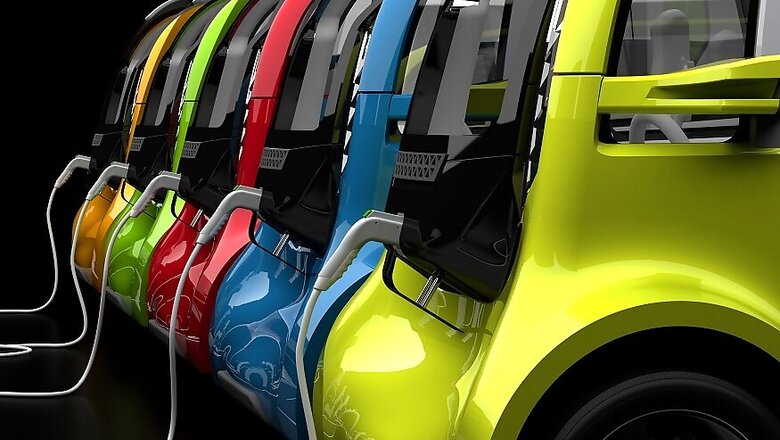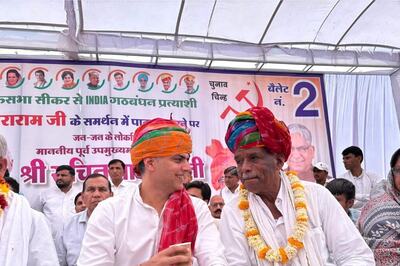
views
New Delhi: Early this year in February when Nitin Gadkari, the road, transport and highways minister, inaugurated Electric Vehicle (EV) charging station at Niti Aayog building in the capital, he emphasised on the burden of crude oil bill on India's exchequer.
"We spend seven lakh crore rupees on importing crude oil in India, which is a big trouble for India's economy...," Gadkari had said. Since then the burden of crude oil bill has increased steadily and falling value of rupee has worsened the situation even more.
As Niti Aayog convenes global mobility summit this weekend, India's automobile industry and pollution experts await a clearer policy and roadmap for electric vehicles. Several companies have electric vehicles ready in their international portfolio, but haven't launched them in Indian market.
Today as our cities choke, especially in winters when pollution levels rise critically, a push for electric vehicle mobility is urgently needed. Transport sector is the third biggest polluter after power and industry but the physical proximity of vehicles to humans, particularly children creates a dangerous scenario.
"Vehicles are very close to us when we walk on the road and so the harm caused by them is far more. For example, if you are in Delhi, the Badarpur power plant is not as close to your nose as any other vehicle would be. Therefore, the toxic exposure is very high," says Anumita Roy Chaudhary, of Centre for Science and Environment, advocating the electric mobility with a robust public transport system.
The worldwide scenario puts India under pressure as we lag behind in electric mobility. From a few thousand cars on road in 2010, globally the number rose to more than four million electric vehicles in last year. Half of the sale of electric vehicles was in China followed by Europe and the US.
Experts advocate that in India a strong policy will set the momentum in the right direction. It includes the supply of top quality electric vehicles and enough incentives for the users. Manufacturers too need incentives. Some states like Maharashtra and Karnataka have shown inclination in this direction. Maharashtra has announced 15% upfront subsidy for the first 100,000 electric vehicles registered and Karnataka is planning to invest more than Rs 30,000 crores to set up EV manufacturing units.
"Of course subsidies and fiscal incentives could provide an initial spurt but non-fiscal incentives will be equally important," says Aarti Khosla, Director of Climate Trends. "Waiving off parking fees, giving preference in public parking, offering innovative models for shared mobility fleets will be the kind of encouragement that EV owners need," Khosla adds.
India has got 14 out of 20 top polluted cities in the world. According to a report by The Lancet Commission on Pollution and Health, India topped global pollution deaths in 2015 when 2.5 million, out of nine million deaths worldwide, died prematurely.
The increasing number of vehicles that run on fossil fuel adds to this concern as the country is fourth largest market of automobile in the world. When it comes to two wheelers India tops the list. According to the Society of Indian Auto Manufacturers (SIAM), around two crore (20 million) two wheelers were sold in India in 2017 and it makes nearly 80% of all vehicles sold in the country.
While manufacturers now begin to focus on electric two wheelers and three wheelers, the biggest issues remain the cost and battery recharging. Battery and its range which when combined with lack of charging station discourages people from buying e-vehicles. So getting our act right involves government working on R&D as well. As no consumer would like to stand in long queues for battery recharge, a sound charging infrastructure is urgently needed. It can take a few years’ time to get set up at full scale.
"Different kinds of charging facilities are required. While two-wheelers will need simple charging points, the three wheelers and cars may be provided charging as well as battery swapping facility," says Ashok Jhunjhunwala, professor of electrical engineering at IIT Chennai.
And how people will be drawn to buy the electric vehicles? This remains a challenge though not an impossible task. This revolution will come by efforts at several levels, say experts. However, manufacturers feel once the vehicles start running on road and people notice them, the sales will increase sharply.
"One million is the number we are aiming for. You touch that number and people will start buying EVs automatically. We won't require any subsidy support then," said Naveen Munjal, Managing Director of Hero Electric in a roundtable organised in Delhi to discuss policy, industry experience and challenges on the issue.
And this won't be just about the sale of electric vehicles and cleaner transport. It is also about jobs and growth in manufacturing. As China already accounting for more than one third of global production, India will have to brace for the competition.
"We just need to get our act right... To save jobs, enhance jobs and enhance GDP. If we do not take such steps, China will start exporting because they are going at a very fast pace. If we don't wake up our two-wheeler, three wheeler and every automobile industry will be captured by them," says Prof Jhunjhunwala.




















Comments
0 comment